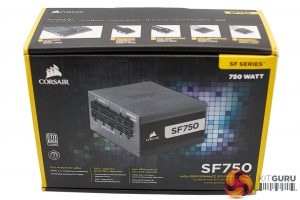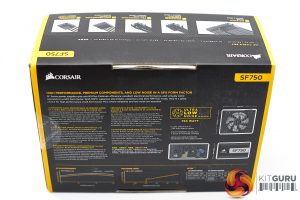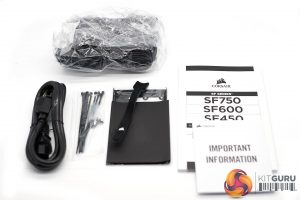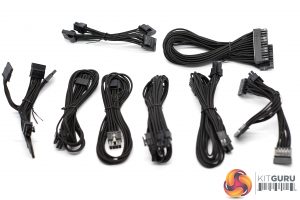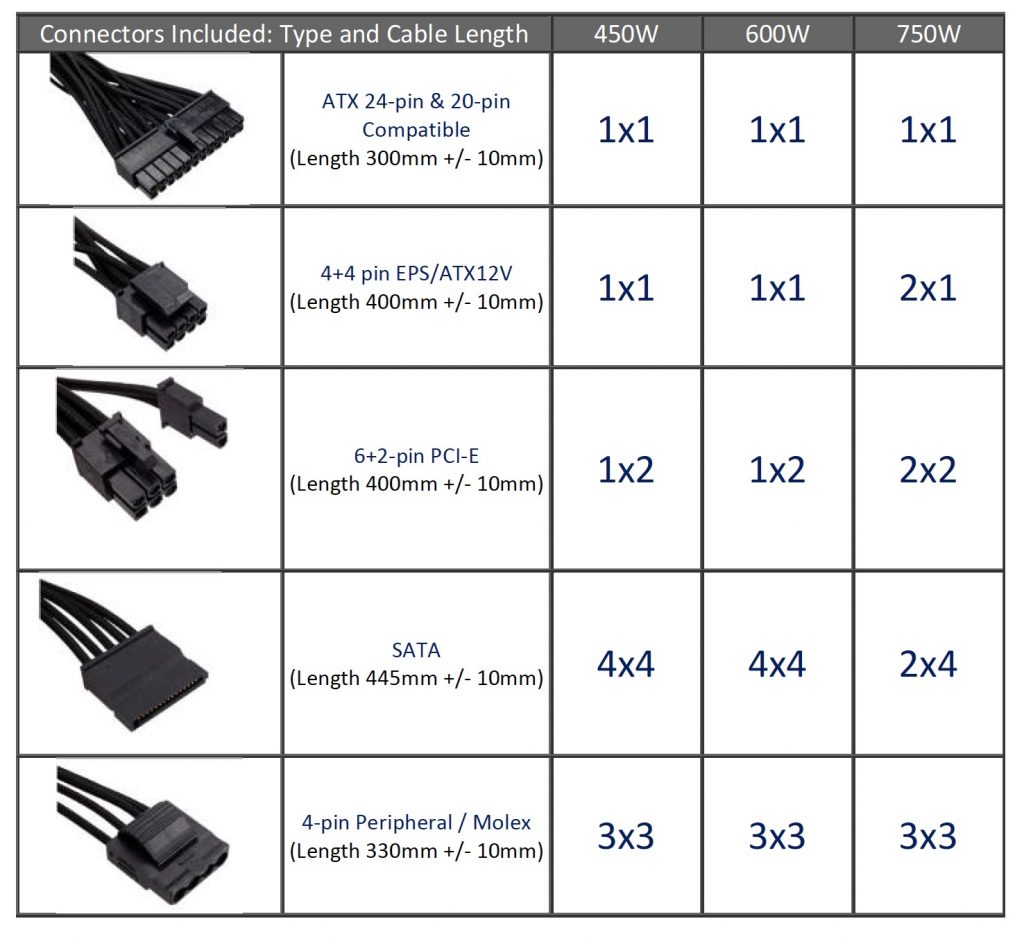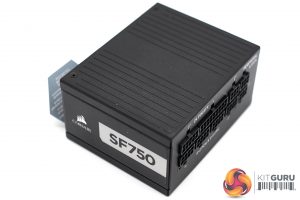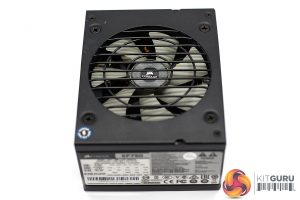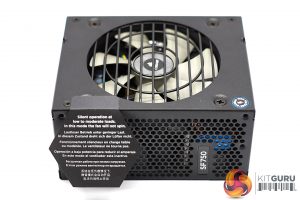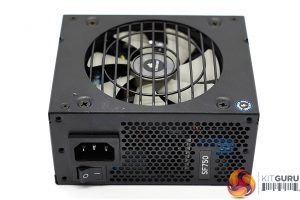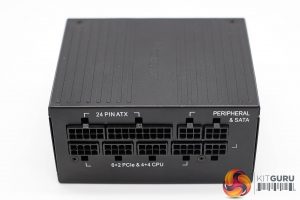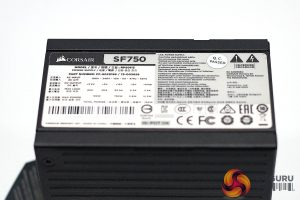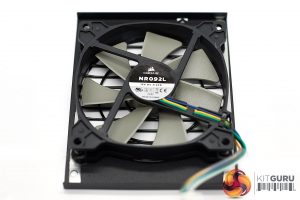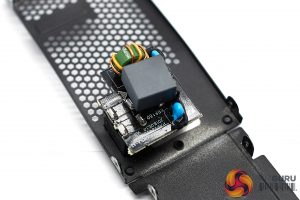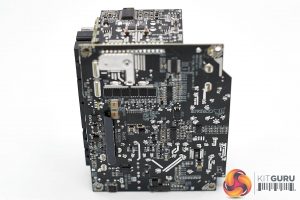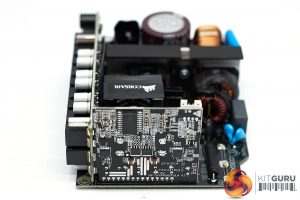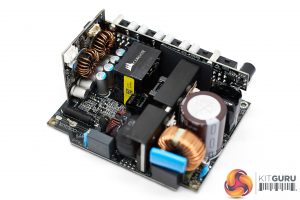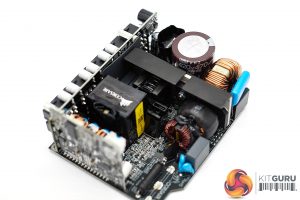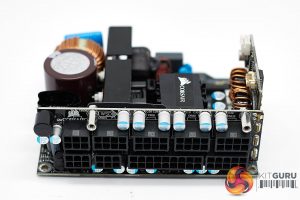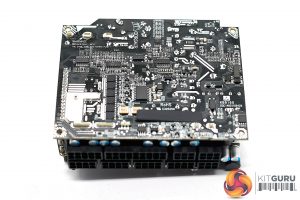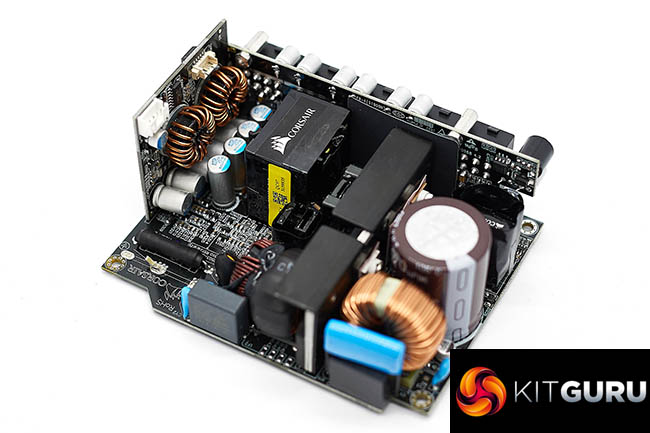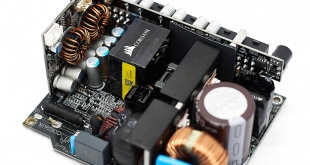
Today we take a look at one of the newest power supplies from market leader Corsair – their new SF750 SFX Platinum. Previously the SF Platinum series shipped in only 450W and 650W capacities, so this new high model will appeal to the hard core enthusiast user looking for a high wattage small form factor supply. This supply also features a larger 92mm fan, rather than 80mm and it has a ‘Zero RPM Fan mode' to reduce noise output under lower load situations.
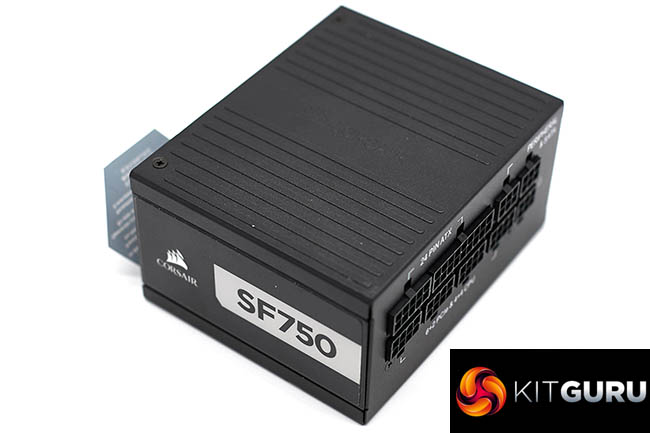
Corsair are keen to point out that lowering noise is one of their key focus points with the SF750. Many small form factor power supplies are equipped with a tiny 80mm fan, which are typically known to generate a lot of noise. By moving to a 90mm fan, they are able to spin the fan slower while producing good levels of airflow – all while reducing noise emissions. They also state that due to careful component selection that coil whine will not be a problem. I will test this out later.
Additionally, as we would expect in this price point, the SF750 is a fully modular power supply featuring very high Platinum efficiency certification. This is a standard sized SFX chassis too – its not one of the extended length versions we see from time to time from other companies.
Features
- An Unprecedented 750 Watt SFX PSU: Harness 750 continuous watts in SFX form, perfect for the most power-dense small-form-factor PCs.
- 80 PLUS Platinum Certification: Ensures ultra-high efficiency operation for less excess heat and lower operating costs.
- Zero RPM Fan Mode: The fan stays off until it’s needed, for silent operation at low and medium loads.
- Individually Sleeved, Fully Modular Cables: Flexible paracord sleeved cables make routing and cable management incredibly easy.
- PWM Cooling Fan: Delivers powerful cooling with low-noise operation.
- 105°C Rated Japanese Capacitors: For unwavering power and reliability.
- SFX-to-ATX Bracket Included: Allows installation into both small form factor and ATX cases.
- Seven-year Warranty: For complete peace of mind.
- Warranty: 7 years.
Photography for this review is completed inhouse with a Canon 1DX MK2 with 50mm f1.2 Prime lens and a Leica S series medium format camera with S series prime lens. Please do not use any of the images within this review without express permission.
We like the box artwork for this power supply, all the key points are listed along the bottom at the front of the box, along with a quality high resolution image in the middle.
Corsair go into more technical detail at the back of the box, if you happen to be browsing in a retail store.
The bundle inside the box is fairly extensive, with a regional specific power cable, user manual and literature, a plastic bag of cables, felt and plastic cable ties, and an SFX to ATX mounting bracket.
The cables are quite beautiful – individually sleeved and finished to a very high standard.
There are a total of eight individually sleeved modular cables in the box and there are plenty of connectors to cater for the majority of enthusiast system builds. We can see that the 750W version also ships with 2 4+4 Pin EPX/ATX12V connectors, a great addition to see. The cables are quite short, intentionally, to ensure system builders are not dealing with very long cables inside a small form factor case. It is worth noting this however if, for some reason you are intend on using this power supply inside a larger chassis.
Connectors
- 1x 20+4-Pin ATX12V/EPS12V
- 2x 4+4-Pin ATX12V/EPS12V
- 4x 6+2-Pin-PCIe
- 8x SATA
- 3x 4-Pin-Molex
The Corsair SF750 is an SFX power supply – and not one of the many extended units we have seen in recent years – its only 63mm x 125mm x 100 mm (HxLxW).
The 90mm fan is hidden behind a metal grill on the top of the unit. We will get a closer look at this shortly when we open the power supply.
There is a large sticker on the case which explains the ‘Zero RPM' fan mode. Less noise is good.
When the sticker is removed, we can see the vented panel, alongside the power connector and button.
The other side of the power supply shows the modular bay- clearly named and split into sections to ease installation.
| Corsair SF750 SFX Power Supply | |||||
|
DC Output
|
+3.3V
|
+5V
|
+12V |
-12V
|
+5Vsb
|
|
Max Output
|
20A
|
20A
|
62.5A |
0.3A
|
2.5A
|
| Total Power | 130W | 750W | 3.6W | 12.5W | |
| 750 watts | |||||
The Corsair SF750 SFX Platinum power supply is rated to deliver a combined, continuous output up to 750 watts at up to 50c. It is based around a single rail design that can deliver up to 62.5A (750W). No problems here.
Corsair are using a 90mm NR092L fan in the SF750 unit. This fan is rifle bearing – a design which circulates lubrication around a long life sleeve bearing to provide longer life than a traditional sleeve bearing fan. Corsair say their fan blades have been tweaked to move air through the power supply while creating less noise than a traditional design. The bearing is enhanced for low RPM airflow by the adoption of an improved motor core and windings.
Below - a High Resolution Gallery of the internal layout of the Power supply.
If you can't see the image gallery above then you will likely need to white list us in your ad blocker as they are known to interfere with our display code.
Corsair are using Great Wall as the partner for this particular power supply design. The layout, construction and overall design is very similar to the SF600 model in the range which we had a look at before. All of the electrolytic capacitors inside are Japanese made, which is good to see – especially as Corsair claim this in their literature. The primary bulk capacitor is made by Nippon Chemi Con rated for 470uF, 420C and 105C.
Correctly testing power supplies is a complex procedure and KitGuru have configured a test bench which can deliver up to a 2,000 watt DC load.
Due to public requests we have changed our temperature settings recently – previously we rated with ambient temperatures at 25C, we have increased ambient temperatures by 10c (to 35c) in our environment to greater reflect warmer internal chassis conditions.
We use combinations of the following hardware:
• SunMoon SM-268
• CSI3710A Programmable DC load (+3.3V and +5V outputs)
• CSI3711A Programmable DC load (+12V1, +12V2, +12V3, and +12V4)
• Extech Power Analyzer
• Extech MultiMaster MM570 digital multimeter
• Extech digital sound level meter
• Digital oscilloscope (20M S/s with 12 Bit ADC)
• Variable Autotransformer, 1.4 KVA
|
DC Output Load Regulation
|
||||||||||
|
Combined DC Load |
+3.3V
|
+5V
|
+12V
|
+5VSB
|
-12V | |||||
|
A
|
V
|
A
|
V
|
A
|
V
|
A
|
V
|
A | V | |
|
75W
|
0.95
|
3.34
|
0.93
|
5.04
|
5.13
|
12.00
|
0.50
|
5.05
|
0.20
|
-12.08
|
|
150W
|
1.65 |
3.34
|
1.66
|
5.04
|
10.61
|
11.98
|
1.00
|
5.05
|
0.20
|
-12.07
|
|
375W
|
3.00
|
3.34
|
3.02
|
5.03
|
28.11
|
11.95
|
1.50
|
5.04
|
0.30
|
-12.07
|
| 565W |
4.05
|
3.33
|
4.07
|
5.02
|
42.94
|
11.92
|
2.00
|
4.99 |
0.30
|
-12.07
|
|
750W
|
4.90
|
3.31
|
5.24
|
5.01
|
57.48
|
11.90
|
2.50
|
4.98
|
0.50
|
-12.06
|
Load regulation proves to be very good, holding within 2% of the recommended guidelines.
| Corsair SF750 SFX | Maximum Load |
| 788W |
We managed to reach around 788W before the unit would shut down gracefully, after the protection kicked in. This is around 40 watts more than the rated output.
Next we want to try Cross Loading. This basically means loads which are not balanced. If a PC for instance needs 500W on the +12V outputs but something like 30W via the combined 3.3V and +5V outputs then the voltage regulation can fluctuate badly.
| Cross Load Testing | +3.3V | +5V | +12V | -12V | +5VSB | |||||
| A | V | A | V | A | V | A | V | A | V | |
| 734W | 1.0 | 3.34 | 1.0 | 5.03 | 60.0 | 11.88 | 0.2 | -12.07 | 0.50 | 5.03 |
| 154W | 15.0 | 3.29 | 15.0 | 4.97 | 2.0 | 12.03 | 0.2 | -12.06 | 0.50 | 5.06 |
The unit passes our Cross Load testing without any problems. When hit with 60 AMPS the +12V rail held at 11.88. Not a very realistic situation in real life, but a good sign that the design works well.
We then used an oscilloscope to measure AC ripple and noise present on the DC outputs. We set the oscilloscope time base to check for AC ripple at both high and low ends of the spectrum.
ATX12V V2.2 specification for DC output ripple and noise is defined in the ATX 12V power supply design guide.
|
ATX12V Ver 2.2 Noise/Ripple Tolerance
|
|
|
Output
|
Ripple (mV p-p)
|
|
+3.3V
|
50
|
|
+5V
|
50
|
|
+12V1
|
120
|
|
+12V2
|
120
|
|
-12V
|
120
|
|
+5VSB
|
50
|
Obviously when measuring AC noise and ripple on the DC outputs the cleaner (less recorded) means we have a better end result. We measured this AC signal amplitude to see how closely the unit complied with the ATX standard.
| AC Ripple (mV p-p) | ||||
| DC Load | +3.3V | +5V | +12V | 5VSB |
| 75W | 5 | 5 | 10 | 5 |
| 150W | 5 | 5 | 10 | 10 |
| 375W | 5 | 5 | 15 | 10 |
| 565W | 5 | 10 | 20 | 10 |
| 750W | 5 | 10 | 20 | 10 |
Noise suppression results are superb, hitting 5mV and 10mV on +3.3V and +5V rails respectively. The +12V rail peaks at 20mV under full load conditions. Great results really overall.
|
Efficiency (%) 240V
|
|
|
75W
|
90.4
|
|
150W
|
92.4
|
|
375W
|
94.2
|
|
565W
|
93.6
|
|
750W
|
92.7
|
Efficiency is excellent, peaking at just over 94% around 50% load. At full load the power supply maintains a 92.7% efficiency level, which is impressive.
We take the issue of noise very seriously at KitGuru and this is why we have built a special home brew system as a reference point when we test noise levels of various components. Why do this? Well this means we can eliminate secondary noise pollution in the test room and concentrate on components we are testing. It also brings us slightly closer to industry standards, such as DIN 45635.
Today to test the power supply we have taken it into our acoustics room environment and have set our Digital Sound Level Noise Decibel Meter Style 2 one meter away from the unit. We have no other fans running so we can effectively measure just the noise from the unit itself.
As this can be a little confusing for people, here are various dBa ratings in with real world situations to help describe the various levels.
KitGuru noise guide
10dBA – Normal Breathing/Rustling Leaves
20-25dBA – Whisper
30dBA – High Quality Computer fan
40dBA – A Bubbling Brook, or a Refrigerator
50dBA – Normal Conversation
60dBA – Laughter
70dBA – Vacuum Cleaner or Hairdryer
80dBA – City Traffic or a Garbage Disposal
90dBA – Motorcycle or Lawnmower
100dBA – MP3 Player at maximum output
110dBA – Orchestra
120dBA – Front row rock concert/Jet Engine
130dBA – Threshold of Pain
140dBA – Military Jet takeoff/Gunshot (close range)
160dBA – Instant Perforation of eardrum
|
Noise (dBA)
|
|
|
75W
|
<28.0
|
|
150W
|
<28.0
|
|
375W
|
29.3
|
|
565W
|
35.7
|
| 750W | 38.9 |
The 90mm fan is not active when the power supply is running at lower power demands. We didn't hear any coil whine either, which is excellent. At higher loads, the fan does spin up a little more, becoming more audible when the load hits around 600 watts. At full load the fan is clearly audible, but it is only 90mm and we would expect this.
This is not the kind of power supply you would want to be running at 750 watt all the time anyway. I personally found that the fan wasn't too annoying at all until the system was loaded to more than 600 watts.
|
Temperature (c)
|
||
|
Intake
|
Exhaust
|
|
|
75W
|
36
|
40
|
|
150W
|
38
|
42
|
|
375W
|
39
|
47
|
|
565W
|
45
|
54
|
|
750W
|
47
|
57
|
The large fan works well to expel heat out the rear of the chassis. The overall results are very good indeed.
|
Maximum load
|
Efficiency
|
|
788W
|
91.6
|
At 788 watts, the efficiency level measures 91.6%. Not a practical situation to be running 24/7, but worth noting.
The Corsair SF750 SFX Platinum power supply is another tour de force showcase from Corsair. They are incredibly strong right now in the small form factor sector and the high output SF750 reinforces their growing status.
Technically there is little, if anything we can fault. Load Regulation is first class, and the unit meets Platinum efficiency levels without a hiccup. The unit design produces tight control over AC ripple mV and we recorded stellar results, even under full load conditions.
We are happy to see Corsair have adopted all Japanese capacitors in both primary and secondary stages to offer long term reliability and stable operation under heavy load conditions. The primary bulk capacitor is by Japanese manufacturer Nippon Chemi Con and is rated 105c.
SFX power supplies always have to make sacrifices in regards to fan noise, and thankfully Corsair have taken some clever steps forward to alleviate this potential headache. They have adopted a larger 90mm rifle (normally 80mm) bearing fan inside this supply, and thanks to Corsair's Zero RPM system, it does not spin at all under lower or even normal load situations.
It is likely if you have this supply in your system and you are doing general work it won't make a noise at all. Under higher load situations, the fan will spin, but until you are close to 80% load, it won't really make its presence known. At full load, the fan is quite noisy but we would expect this – after all it is still only 90mm in diameter.
We tested this power supply and it was not only able to deliver a continuous 750W, but it almost delivered 790W before it shut off safely. This is very reassuring to see and we recorded a long run at 770W load without any problems or potential shut down issues occurring.
I deliberately tried to exacerbate potential coil whine issues, by running this power supply in a system with a RTX 2080 and by pushing some games at very low resolutions and extremely high frame rates over long time periods, but i am happy to report that no coil whine was noticeable, with our review sample anyway.
The Corsair SF750 SFX is without doubt one of the finest SFX power supplies that any company has ever made, however be prepared to pay quite a lot of money to own one as they are currently available from Overclockers UK for a wallet sapping £142.99 inc vat HERE. SFX is a niche market hence the high asking price, but if you simply must have the best power supply in this sector, then the Corsair SF750 deserves some serious attention.
Pros:
- Able to deliver almost 790 Watts under load.
- Very quiet under normal circumstances.
- Ripple suppression is first class.
- No coil whine.
- 7 year warranty
- 105c rated capacitors throughout
- high levels of efficiency, achieving Platinum rated levels.
Cons:
- Cables are intentionally quite short, might not be ideal inside a larger case.
- expensive, due to the nature of this market.
KitGuru says: If you are building a high end gaming system inside the SFX platform then this should be right at the top of your list.
 KitGuru KitGuru.net – Tech News | Hardware News | Hardware Reviews | IOS | Mobile | Gaming | Graphics Cards
KitGuru KitGuru.net – Tech News | Hardware News | Hardware Reviews | IOS | Mobile | Gaming | Graphics Cards


